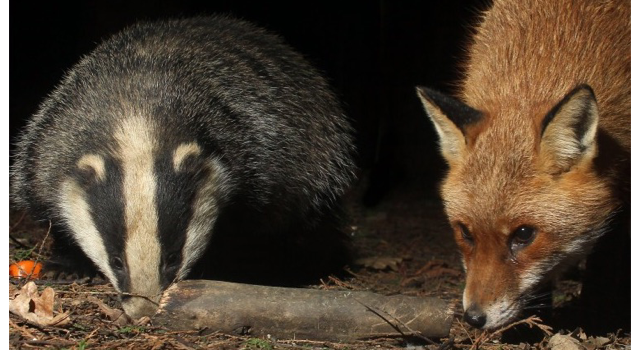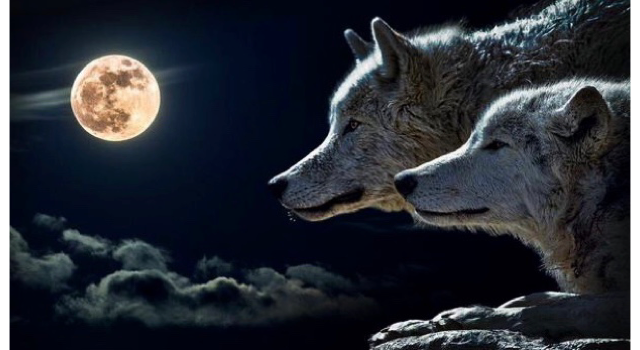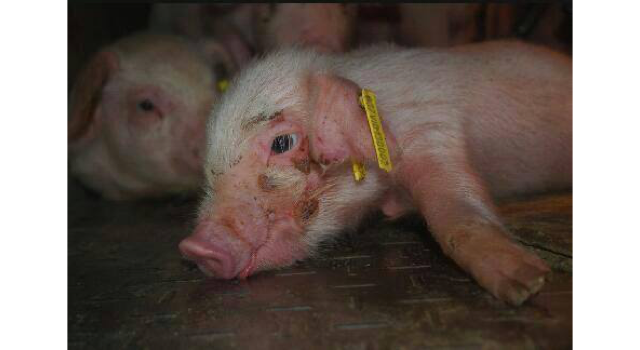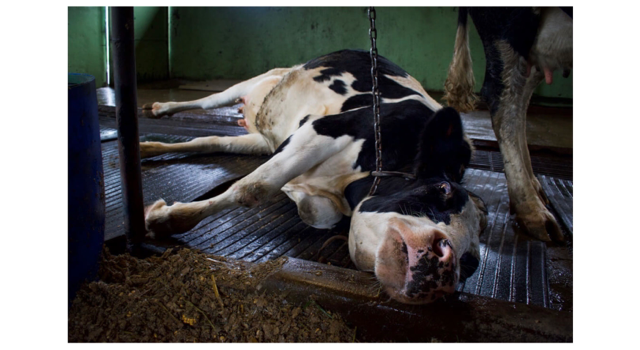France’s hunger for frogs’ legs is “destructive to nature” and endangering amphibians in Asia and…

Millions Of Pigs Killed Due To African Swine Fever.
It is being described as the biggest animal disease outbreak the world has ever seen.
Its impacts are already profound in Asia and beyond.
The virus has spread across the whole of China since it was first discovered in August 2018.
Official figures from China show the national pig herd had declined by 32% year-on-year by July 2019, with an estimated 100 million pigs lost already.
While some of the losses will be directly or indirectly linked to the disease itself, the reduction is also being heavily driven by vast numbers of producers choosing to slaughter their herds and get out of pigs before the virus gets to them.
Rabobank is forecasting that, by the end of the year, China’s pig herd will have halved.
Given that it numbered 700 million and accounted for half the world’s pigs before African Swine Fever struck in August 2018, the damage the virus is causing is plain for all to see. And that is just China.
African Swine Fever is continuing to spread across Asia at a worrying rate, confirmed in September for the first time in South Korea, where six cases were confirmed within two weeks, and the Philippines, where 12 cases were recorded in one area in a short time.
In Vietnam, infected soon after China, the virus has reached all 63 provinces and around 5 million pigs have been killed.
African Swine Fever has also been recorded in North Korea, Vietnam, Cambodia, Laos, Mongolia, Hong Kong and Myanmar.
So far.
( Alistair Driver, 10.10.2019 )
If you eat them, why don’t you go to a slaughterhouse, just before a psycho cuts their throat, and tell the poor souls that their life has no value, and your life does.
( Rose Winfold )
Extreme Heat Kills Thousands Of Flying Foxes.
The 30,000 grey-headed flying foxes in Yarra Bend Park, just outside the heart of Melbourne, Australia, were having a fairly routine early spring.
In September and October— springtime in Australia and prime birthing season for the 28-centimetre long megabats— many of the flying foxes had returned to the park from their winter migration up the coast.
Females were birthing pups as normal.
All was routine.
And then the horror started.
It got too hot, too quickly.
Incapable of surviving the extreme, relentless heat that gripped Melbourne in December, the flying foxes were dying.
Across three days just before Christmas, 4,500 of the park’s grey-headed flying foxes perished— 15% of the colony’s population.
The tragedy for flying foxes in the park echoes scenes of wildlife suffering across the country and puts a spotlight on the perils of extreme heat, which for some species can be just as deadly as fire.
The colony in Adelaide suffered even worse.
Several thousand flying fox babies died there from extreme heat between November and January.
On January 4, many thousands of flying fox babies died across multiple roosts in and around the Sydney region of New South Wales, where the temperature reached a record-breaking 49 deg.C.
This summer’s extreme heat and extreme fires, which have imperilled Australia’s entire eastern coast—prime flying-fox habitat risk wiping out the 2019 generation of newborn bats.
Some 80% of flying fox pups are born in October.
They were young and vulnerable when heat waves and wildfires broke out late last year.
Between 1994 and 2007, approximately 30,000 grey-headed flying foxes died in extreme heat events in Australia.
( Natasha Daly, 07.01.2020 )
People that eat meat either don’t give a shit about animals, or their head is stuck so far up their arse they are oblivious to the horrors that take place and the unimaginable suffering.
( Rose Winfold )
The Despicable Live Animal Export Business.
Every year nearly 2 billion farm animals are loaded on to trucks or ships and sent to new countries in journeys that can take days and sometimes weeks.
Every day, at least 5 million animals are in transit.
Rising demand for meat in many parts of the world has been a boon for exporters who specialise in breeding or in animals that need to be fattened before slaughter.
In the Middle East, in particular, animal imports have risen markedly: in 2016, Saudi Arabia alone imported nearly $1billion worth of live animals.
Hong Kong’s reliance on importing animals from China has fuelled fears of greater dependence on the mainland. In turn, other countries rely on selling their farm animals overseas.
Romania, for example, exports more than 2 million sheep a year.
Sudan’s trade with Saudi Arabia – where it sends several million sheep annually – is one of its most important sectors.
Australia, Denmark and Spain also have thriving export industries.
But the steadily growing trade has led to concerns about the lack of oversight of animals in transit and when they reach their destination.
Poor conditions during transportation and inhumane slaughter on arrival are two issues raised by animal charities that are calling for better regulation of the industry.
There are also fears about the spread of disease.
Abuse or bad animal practices, such as cutting the tendons in a cow’s legs in order to stop it moving before slaughter, or repeatedly stabbing into the side of the neck in order to kill, have been exposed in a number of slaughterhouses in Egypt, Lebanon and Saudi Arabia.
The US, UK and France have all recorded fewer, larger meat plants, meaning animals must travel longer distances, and even into other countries, for processing.
( Hilary Osborne and Bibi van der Zee, 20.01.2020 )
Mankind is not the only animal that loves, thinks, cares for their children, and feels pain.
The sooner we acknowledge that animals are sentient, emotional beings, the sooner we will cease exploiting them and doing them harm.
Animals share this earth with us and have as much right as we do to be free and to live in peace.
We must embrace them as neighbours, perhaps even as our brothers and sisters.
( Rose Winfold )
Humans Kill Millions Of Wildlife Animals And Destroy Their Habitat.
As humans continue to develop natural areas, animals’ homes continue to disappear.
And as animals search for food, water, shelter, and a place to raise their young, they’re often deemed “nuisances” or “pests” or said to be “over-populated”.
Each year, millions of them are killed because humans have taken over their living areas and don’t want them there.
Canada geese, rabbits, raccoons, chipmunks, mice, rats, wasps, beavers, bats, snakes, ducks, prairie dogs, and pigeons are among the types of wildlife who most often suffer because of a perceived conflict with humans.
Animals ask for very little except for the opportunity to live in peace.
But adding to their struggle to survive are hunters, who enjoy stalking and killing them even when they make their homes far away from cities.
Hunters frequently victimise bears, coyotes, ducks, foxes, mountain lions, prairie dogs, deer, geese, and wolves.
Anglers like to trick fish into biting on hooks that pierce their faces before pulling them out of the water and allowing them to suffocate.
And trappers lay traps that slam shut on unsuspecting animals’ legs so that they can kill them for being a “nuisance” or for their fur.
( PETA )
We live in a wonderful world that is cursed by a disease called “Cruel Ignorant Man”.
The Cruel, Unnecessary, Slaughter Of Badgers.
The culls have expanded to unimaginable scales, covering an area larger than Israel.
I cannot understand why the government has permitted this massive expansion of badger culling, when it has not yet responded to the Godfray Review it commissioned and received nearly a year ago.
The review concluded the government and farming industry were paying far too much attention to badger management, and far too little attention to cattle-to-cattle transmission, which is responsible for the majority of TB incidents in cattle.
The review also called upon government to properly evaluate badger vaccination as a non-lethal alternative to culling.
Ministers regularly call for the conservation of wildlife in other countries, but refuse to invest in helping their own farmers to coexist with wildlife.
( Professor Rosie Woodroffe, Ecologist, Zoological Society of London, September 2019 )
We teach our children to be kind to all living creatures.
And then we feed them with pieces of a murdered animal.
Using The Name Of God To Justify The Killing Of Animals.
Just for those religious people out there who seemed to have forgotten.
In the beginning, when Adam and Eve were in the Garden of Eden, they did not eat meat, for the lion would lay with the sheep and the man could approach the lion.
There was no killing, until they disobeyed God and the lion turned on the man and suffering came to be.
God said that when the end came and people were judged, those who were good would go to heaven, or a paradise land where again, man could approach the lion in a friendly manner, and the lion would lay next to the sheep in peace once again.
So for you to say God gave us animals for the benefit of eating is absolute bull-shit.
According to all the Abrahamic teachings, eating the flesh of another living creature is part of the punishment bestowed upon man for disobeying God, seeing as eating meat was not done in the Garden of Eden, making it a part of the Devil’s world, not God’s.
I am not a religious person at all, but I was brought up in a religious home and taught the teachings and it seems to me as though people who try to use the “God gave us animals for the purpose of eating them” argument, leave out the bit of important information that clearly states that animals were originally made by God for man as companions.
They seek to use the “God made animals for eating” argument to justify the cruelty inflicted on animals for our own selfish desires.
And the contradictions of religion continues.
( Kayla Soliman )
Don’t ask me why I don’t eat the flesh from animal corpses.
Ask yourself why you do.
Badgers Are Being Pushed To The Verge Of Extinction.
This year will take the number of badgers killed since the cull started to over 130,000, pushing the species to the verge of local extinction in areas of England which it has inhabited since the ice age.
The public costs of the badger cull are estimated to exceed £60million by the end of 2019, yet the government has provided no evidence to prove this cruel slaughter is having any significant impact on lowering bovine TB.
( Dominic Dyer, chief executive of the Badger Trust, September 2019 )
If you want to eat ‘meat’, then animals have to suffer and die, baby animals have to suffer and die.
The choice is simple.
The choice is yours.
Cows May Be Conscious As Their Bodies Are Hacked Apart.
Animals on organic and “free-range” farms often endure the same cruel mutilations –– such as debeaking, dehorning, and castration without painkillers –– as animals on conventional factory farms.
Cattle, for example, generally have their horns cut off and their testicles cut out of their scrotums, and many are branded with searing-hot irons.
Pigs on organic farms often have their tails cut off and their ears notched, and some have rings forced into their sensitive noses in order to prevent them from rooting in the grass and dirt, which is a favourite pastime of pigs.
Chickens on organic egg farms usually have part of their sensitive beaks cut off, which causes them both acute and chronic pain.
At the end of their miserable lives, these animals are typically shipped on trucks through all weather extremes –– usually without food, water, or rest –– to the same slaughterhouses used by factory farms.
There, the animals are hung upside down and their throats are cut, often while they’re still conscious and struggling to escape.
Many chickens are still able to feel pain when they’re submerged in the scalding-hot water of the defeathering tanks, and cows may be conscious as their bodies are hacked apart.
( PETA )
I don’t believe anyone can live a healthy and a peaceful life when they consume suffering and violence.
( Rose Winfold )
Thanks To Boris Johnson’s Girlfriend, Derbyshire Badgers Won A Reprieve.
Farm leaders have slammed the government for rejecting a farmer-led application to cull badgers in Derbyshire, which is considered in the ‘edge area’ for bovine TB.
Bill Harper, National Beef Association TB committee chairman, said: “The application for Derbyshire was turned down at the last minute and we cannot understand why.
It met with all the protocols and criteria.
Natural England has not given us any explanation.
We believe this decision was taken purely on political and not scientific grounds.
I’m convinced that it is Derbyshire Wildlife Trust that has won the day.
Their representatives include Chris Packham and Dominic Dyer, chief executive of the Badger Trust.
It is almost like Boris Johnson is saying: ‘Oh, right darling, we will not allow that one’.
Nobody has ever got to this stage and been turned down.
There are no reasons why they should be turned down.
They had done everything they had been asked to do. It stinks.
The problem you have got is the signal it sends out to any other areas considering doing all the work.
It was one of the best applications we have seen.
Mr Harper was referring to suggestions that the prime minister’s girlfriend, Carrie Symonds, an opponent of the badger cull, had convinced him not to extend the policy to Derbyshire.
( Philip Case, 10.09.2019 )
I’ve often heard meat-eaters defend their habit by saying:
“God made animals for us to eat”.
Why would a supposedly loving God create animals with a brain and a central nervous system which allows them to have emotions and feel pain like we do?
The Devil, perhaps.
But not a loving God.
Millions Of Animals Are Tortured And Killed Every Year In Laboratories.
Each year, more than 100 million animals, including mice, rats, frogs, dogs, cats, rabbits, hamsters, guinea pigs, monkeys, fish, and birds, are killed in U.S. laboratories for biology lessons, medical training, curiosity-driven experimentation, and chemical, drug, food, and cosmetics testing.
Before their deaths, some are forced to inhale toxic fumes, others are immobilised in restraint devices for hours, some have holes drilled into their skulls, and others have their skin burned off or their spinal cords crushed.
In addition to the torment of the actual experiments, animals in laboratories are deprived of everything that is natural and important to them.
They are confined to barren cages, socially isolated, and psychologically traumatised.
The thinking, feeling animals who are used in experiments are treated like nothing more than disposable laboratory equipment.
Diseases that are artificially induced in animals in a laboratory, whether they be mice or monkeys, are never identical to those that occur naturally in human beings.
And because animal species differ from one another biologically in many significant ways, it becomes even more unlikely that animal experiments will yield results that will be correctly interpreted and applied to the human condition in a meaningful way.
Because experimenters rarely publish results of failed animal studies, other scientists and the public do not have ready access to information on the ineffectiveness of animal experimentation.
( PETA )
People who eat meat should spend less time worrying how plants become burgers and more time worrying how animals become burgers.
The Ignorant And The Mindless Participate In Wildlife Killing Contests.
Contestants use digital technology to lure animals like foxes and coyotes to their death, and then riddle them with bullets in a mad rush to kill the most animals, and then dump the animals like garbage once the contest is over.
Footage captured by the Humane Society of the United States at two such contests, the “Predator Hunters of Maryland” event in Unionville and the “Southern Maryland Predator Hunt” in Waldorf, shows contestants unloading foxes, coyotes and raccoons with gruesome injuries, their bodies bloody and ripped apart by bullets, from trucks.
Worse, children seemingly inured to the violence play among the dead animals and even help drag them to the judging area.
Altogether, about 200 dead animals were placed before the judges in Unionville.
Contestants were judged on a point system — killing a coyote earned five points, a fox three points and a raccoon one point.
Prizes were also awarded for the heaviest coyote, the heaviest fox and the heaviest raccoon killed.
The winner of the Unionville contest took home a cash prize of around $400 for killing 38 foxes.
At the Waldorf contest, the winning team killed 27 foxes during the approximately 16-hour allowable “hunting” window.
Sadly, these are not the only contests of their kind in the state.
At the 2019 Annual Central Maryland Predator Competition in Mount Airy, 236 red foxes, gray foxes and coyotes were killed; and the “Coyote in the Hills Hunt” is taking place right now in Oakland, Maryland, where participants are competing to kill the most coyotes for cash prizes.
Such unnecessary carnage is shocking to anyone with an iota of compassion.
As more and more scientists and state wildlife agencies are pointing out, wildlife killing contests also serve no credible conservation purpose.
In fact, they may create many more problems by removing animals who play important roles in their ecosystems.
For instance, the Maryland Department of Natural Resources reports that red fox populations are declining in some areas.
Foxes provide balance in nature and, like all wild carnivores, they regulate their own numbers according to available habitat and prey.
Also, when adult foxes are killed, dependent young may be orphaned and left to die from starvation, predation or exposure.
But participants at one of the contests told our investigators — naively and wrongly — that killing contests create balance in nature because “people aren’t wearing fur anymore and the fox population gets out of control.”
Unfortunately, such ignorance and indifference to animal cruelty is not unique to Maryland.
( Kitty Block, President and CEO of the Humane Society of the United States and CEO of Humane Society International, 19.02.2020 )



This Post Has 0 Comments